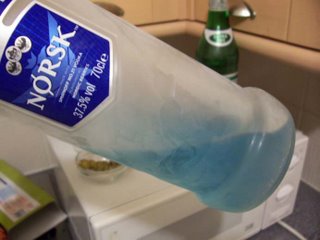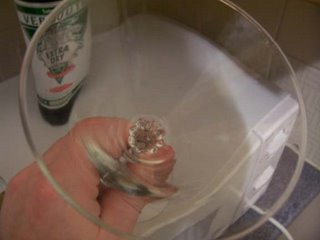And following firmly in Ian Fleming's footsteps, I know a lot about Martinis.

The other day, some cocky kid (I know he was cocky, he called me 'Ginge') challenged me to 'flair' a bottle of champagne. Which I can't do, because I'm not one of these TGI Friday barmen who can spin bottles around.
I'm a 'mixologist.'
A mixologist creates drinks. Flairing bottles is all fine and dandy (okay, it's a very cool art and I'm jealous of it) but when it comes to bartending, the flair is the icing on the cake. It's just 'flair' as they say. You can spin as many bottles as you like, but even if you impeccably serve up coffee syrup with tomato juice, it's going to taste horrible.
No, the real artists behind cocktails are the mixologists. They're the ones who, back in the days of prohibition, managed to mix fruit juice and soda into the cheapest bathtub gin to make it drinkable.
Bartenders are cooks. Mixologists are chefs.
And at the height of the mixologist's art is the Martini.
The Martini is truly a wonderful creation. It's the simplest, yet most complex of drinks. And, like so many things, I only truly understood it when I went to America.
It was called The Tar Bar and the guy who ran it was called Vincent, and he had an entire back room dedicated to Frank Sinatra. Located on the Upper East Side, it was the first bar I ever went to in America and it sticks in my memory like the Tartini he served stuck in my gullet.
That was the night I discovered what a REAL martini tasted like - because until then, I'd never had one. Oh, sure, you could ask for a martini in England, but unless you were at the Ritz, you'd get a lukewarm 30ml serving of Vermouth.
No, the first time I had a real Martini was in America. And in addition to learning about the secret of a proper Martini, I learned the essential rule when dealing with this suave beverage. Three is enough. Any more than that and the Martini takes control.
I learnt that the hard way, when I ended up catching the train to Hoboken instead of the homebound LIRR to Huntington. (In retrospect, I think I ended up in Hauppague, but it's my word against the rest of the world's.)
Anyway. Ever since then, I have been a real fan of the martini. And not just because of the James Bond reference (although that's why I'd been why I'd been ordering 30ml shots of Vermouth in dodgy Welsh pubs.) I loved the Martini because it was such a sublime, gorgeous drink.
So finally, after years of enjoying them, I have finally decided to unleash my own martini on the world.
I feel qualified to because I've drunk as many martinis as anybody... Well, except Faye Dunaway. And there are a million ways of combining gin/vodka and vermouth to create an exclusive drink. Go to any bar in America and ask for the 'house' Martini and you'll get a different version.
I invented this one. And it's good:
The Wintini - The Instant Martini.
I call it the Instant Martini, because there's no need for a cocktail shaker or ice cubes. This is a martini in it's purest sense. And since I invented it here in Winchester, why not call it the Wintini?
You will need:

A bottle of good quality Vodka. I recommend Stolichnaya, which is what James Bond was partial to. A grain based vodka, made in Russia, it's 40% a.b.v. and smooth as Roger Moore in a blender.
A bottle of Extra Dry Vermouth. I'd recommend Noilly Prat (that's Noy-ee PraT) since it's probably the finest vermouth going. Speaking of which, how the hell do Vermouth manufacturers keep in business? I've been making martinis for years and barely made a dent in my bottle. It's like stones ginger wine. You buy one bottle and it sits in your pantry for the next twenty years gathering dust. I'd wonder why anybody needs a new one - but apparently they keep flying off the shelves at Sainsburys.
Green Olives. Because when it comes to olives, I believe in apartheid.
Martini Glasses. Chilled.
In order to make the Wintini, you need to first make sure the vodka is good and frozen.
At 40% a.b.v., the temperature of your freezer won't freeze your vodka. Ideally, it will turn it into a gloopy syrup. At best, it will turn it into a slushy mush. This is the ideal temperature of a Martini and normally Martinis are shaken (over ice) or stirred (over ice) to get it to freezing temperature. The secret of the Wintini - why it's an instant Martini - is that the vodka comes direct from the fridge. It's not diluted in any way, but ice cold, the way a Martini should be.

Preparing the glasses: Vermouth the is the key to a Martini. Some people suggest a light spray of vermouth over the top of the glasses. Some mixologists give a nod to a picture of the inventor of vermouth. The secret, in any way, is the bare minimum of vermouth.
What they never learned in England, but is standard practice in America, is the swish and slosh. Pouring a measure of vermouth into the glass, swilling it around and then pouring it out.

That way, the glass has a thin lining of vermouth.

Once each glass is prepared, simply add the frozen vodka. If it's cold enough, it might be lumpy... Give the bottle a shake and then pour the frozen nectar into the glass.
Garnish with four olives and there you go. The Wintini.

No cocktail shaker or mixing jug needed. An Instant Martini.

No comments:
Post a Comment